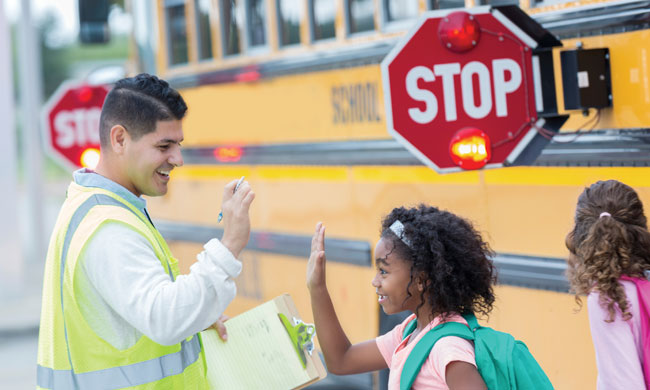(Family Features) For millions of school-age children in the United States, each day begins – and ends – with a bus ride. While the school bus is the safest way to travel to and from school, according to the National Association of Pupil Transportation (NAPT), it’s important for parents to teach their children how to stay safe in and around the school bus as obstructed views, distracted drivers and more can put kids at risk.
These tips from the experts at NAPT and the Propane Education & Research Council (PERC) provide parents with some additional measures to take and lessons to teach to increase safety going to and from the bus, and even during the ride.
Before the Bus Arrives
- Ensure backpacks are packed securely so papers and other items don’t scatter as the bus approaches.
- Create a morning routine that puts kids at the bus stop five minutes before the scheduled pickup time. This helps avoid a last-minute rush, when safety lessons are easily forgotten, and ensures kids are safely in place for boarding.
- Encourage children to wear bright, contrasting colors so they can be seen easier by drivers.
- Walk young children to the bus stop or encourage kids to walk in groups. There is safety in numbers; groups are easier for drivers to see.
- If kids must cross a street, driveway or alley, remind them to stop and look both ways before crossing.
- Verify the bus stop location offers good visibility for the bus driver; if changes are needed, talk with nearby homeowners or school district officials to implement changes. Never let kids wait in a house or car, where the driver may miss seeing them approach the bus.
- Remind children that the bus stop is not a playground. Balls or other toys could roll into the street and horseplay can result in someone falling into the path of oncoming traffic.
- Instruct children to stay at least three steps away from the road and allow the bus to come to a complete stop before approaching it.

On the Bus Ride
- When boarding the bus, items can get bumped and dropped. Caution children that before picking anything up, they should talk to the driver and follow instructions to safely retrieve their possessions.
- Teach safe riding habits: stay seated with head, hands and feet inside at all times; keep bags and books out of the aisle and remain seated until the bus stops moving.
- Instruct children to never throw things on the bus or out the windows and to never play with or block emergency exits.
- Remind kids that just like when riding in a car, loud noises are off limits so they don’t distract the driver. That includes cellphones and other electronic devices; instruct children to put them on mute or use headphones.
Leaving the Bus
- Remind children to look before stepping off the bus. If they must cross the street, teach them to do so in front of the bus by taking five big steps (approximately 10 feet) away from the front of the bus, looking up and waiting for the driver to signal that it is safe.
- For parents who meet their kids at the bus, remember that in their excitement kids may dart across the street. Eliminate the risk by waiting on the side of the street where kids exit the bus.
- Make the bus ride part of your daily “how was school?” discussion. Encourage kids to talk about the things they see and hear on the bus so you can discuss appropriate behaviors and, if necessary, report any concerns to school administrators. As bullying is prevalent and buses are no exception, ask your child to tell you about any bullying they observe, whether against another child or themselves, and talk about how to shut down bully behaviors.
For more information and additional school bus safety tips, visit BetterOurBuses.com.

An Alternate Form of Transportation
Many school districts are moving away from diesel buses in favor of buses powered by an alternate fuel, like propane, which offers numerous benefits for school districts and their students.
In fact, school buses powered by propane transport approximately 928,000 students to and from school every day at more than 840 public and private school districts in 48 states, according to a vehicle registration report compiled by PERC using IHS Polk new vehicle registration data.
“There’s a lot to like about propane school buses for community stakeholders and school officials, and school districts across the nation continue to take notice,” said Michael Taylor, PERC director of autogas business development. “Compared to other fuels, propane school buses are quieter and offer reduced emissions. Plus, they cost less for the district to operate, so schools can put more money back into the classroom where it helps students most.”
Safety
Among the numerous safety advantages propane school buses provide, engines powered by propane are noticeably quieter than diesel engines, which can help ensure a safe ride. Plus, just like all buses, propane buses are crash tested to ensure they meet U.S. Federal Motor Vehicle Safety Standards for side and rear impact. In addition, an automatic shut-off valve prevents the flow of fuel to the engine when it’s not running, even if the ignition is turned on.
Cleanliness
The World Health Organization and the Environmental Protection Agency have identified diesel engine exhaust as a carcinogen, which can cause short- and long-term health effects. With the emergence of alternative fuels like propane, which provides a clean emissions profile compared with diesel and gasoline buses, there is decreased risk of exposing young passengers to harmful particulate matter that can be found in the exhaust in older diesel buses, which can escalate breathing-related issues and aggravate asthma.
Cost-Effectiveness
Financially, propane buses provide school districts with the lowest total cost-of-ownership compared to other fuel types, according to PERC. Even as gas prices continue to fluctuate across the country, propane consistently costs less per gallon than diesel and gasoline, by as much as 50 percent, which saves districts significant money on fuel costs. They also require less maintenance over the lifetime of the vehicle, saving additional money on upkeep. Savings on transportation can help keep more money in the classroom helping students learn.
Start a discussion with your children’s school district about exploring a switch from diesel buses to cleaner alternatives by first downloading resources including fact sheets, videos, a toolkit and more at BetterOurBuses.com.
Photo Courtesy of Getty Images (Bus driver with girl, Two girls talking on bus)




















